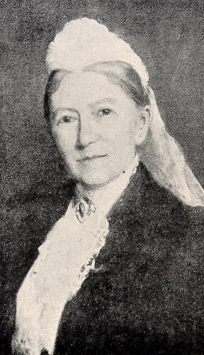Eliza Brightwen
Eliza Brightwen | |
|---|---|
 | |
| Born | Eliza Elder 30 October 1830 |
| Died | 5 May 1906 (aged 75) |
| Nationality | Scottish |
| Spouse | George Brightwen |
Eliza Brightwen (also known as Lizzie Brightwen or Eliza Elder) (30 October 1830 – 5 May 1906) was a Scottish naturalist. She was self-taught, and many of her observations were made on the grounds of The Grove; this was the estate she shared with her husband during his lifetime, and where she as widow. She was described, in 1912, as "one of the most popular naturalists of her day."
Personal life
Eliza Brightwen was born in 1830 in Banff, Aberdeenshire, Scotland. Her parents were named George and Margaret Elder. Brightwen had three other siblings. Her mother died in 1837 and her father was dead by that time, too.[1][2] Brightwen was adopted, after her mother died, by her uncle, Alexander Elder. He was a co-founder of Smith, Elder & Co. Brightwen moved to Streatham to live with her uncle. She then moved to Stoke Newington. She did not receive formal education.[1] She expressed interest in natural history as a child and described her youth as "extremely lonely and quiet."[3] She married George Brightwen in 1855. He was a banker before he quit to run his own business in which he made a lot of money. The couple moved to Stanmore and living in a home called Elderslie in Bushey Heath.[1][4]
Brightwen suffered from health problems. She had a nervous breakdown in 1872. She lived as a recluse for ten years, with little to no contact with her husband and friends. She rarely left the house and did not read. George Brightwen died in 1883. She came out of her reclusiveness and to be active intellectually and physically. She continued to suffer from body pains for the rest of her life. She continued to rarely leave The Grove.[1]
Brightwen lived in Stanmore until she died in May 1906. Their home, The Grove, was an estate with 170 acres of grounds where she did much of her research.[1][4] They renovated the house. The remodel was done by Brightwen Binyon. She made the billiard room into a museum after her husbands death.[5] She was a philanthropist and attended church regularly. She had no children. She is buried at a church in Stanmore.[1]
Work
Brightwen did much of her research on location in the woods and grounds of her home, The Grove. She started writing about her work when she was sixty. In 1890, she published Wild Nature Won by Kindness, about animal life. She became well known as a naturalist. In 1892, she published her second book, More about Wild Nature, followed by Inmates of my House and Garden, in 1895. It is considered her master work. She published a total of six publications during her lifetime. She socialized with Philip Henry Gosse (whose second wife, also named Eliza Brightwen, was her husband's sister), William Henry Flower, William Hooker, and James Paget.[1] She also wrote about the concept of "home museums," as written in More about Wild Nature. The concept of home museums stems from her own home museum at The Grove.[5]
Upon her death, a collection of essays were published titled Last Hours with Nature. An autobiography was also published, with an epilogue by Edmund Gosse, who was her nephew.[1]
Bibliography
- Brightwen, Eliza. Glimpses into Plant Life. (1898) ISBN 1149384018
- Brightwen, Eliza. Inmates of my House and Garden. (1895) ISBN 0559909659
- Brightwen, Eliza. More about Wild Nature. (1892) ISBN 1164177125
- Brightwen, Eliza. Quiet Hours with Nature. (1903)
- Brightwen, Eliza. Rambles with Nature Students. (1899)
- Brightwen, Eliza. Wild Nature Won by Kindness. (1890)
Further reading
- Gosse, Edmund (editor). Eliza Brightwen : the Life and Thoughts of a Naturalist. (1909)
References
- ^ a b c d e f g h
 This article incorporates text from a publication now in the public domain: "Brightwen, Eliza". Dictionary of National Biography. London: Smith, Elder & Co. 1885–1900.
This article incorporates text from a publication now in the public domain: "Brightwen, Eliza". Dictionary of National Biography. London: Smith, Elder & Co. 1885–1900.
- ^ "Eliza Brightwen's funeral was recorded in the Harrow Observer under the heading DEATH AND FUNERAL OF". Ancestry. Retrieved 6 August 2013.
- ^ Bernard Lightman (15 October 2009). Victorian Popularizers of Science: Designing Nature for New Audiences: Designing Nature for New Audiences. University of Chicago Press. pp. 439–449. ISBN 978-0-226-48117-3. Retrieved 5 August 2013.
- ^ a b "Eliza Brightwen". Ancestry. Retrieved 6 August 2013.
- ^ a b "The Grove Home Museum". Ancestry. Retrieved 6 August 2013.
External links
- Works by Eliza Brightwen at Project Gutenberg
- Works by or about Eliza Brightwen at the Internet Archive
- Works by Eliza Brightwen at LibriVox (public domain audiobooks)

